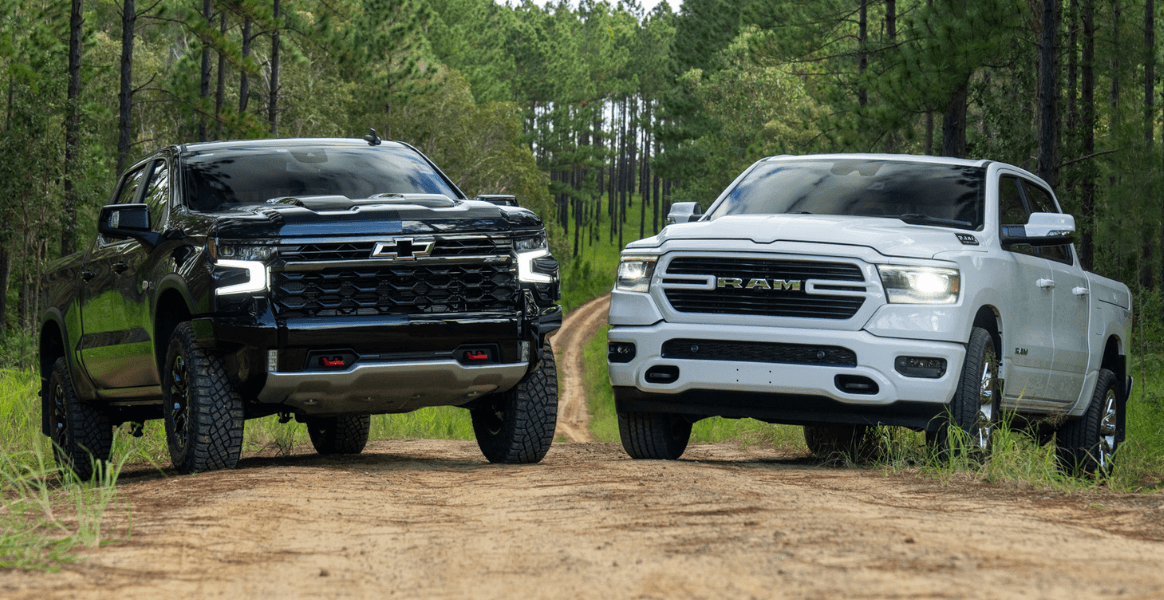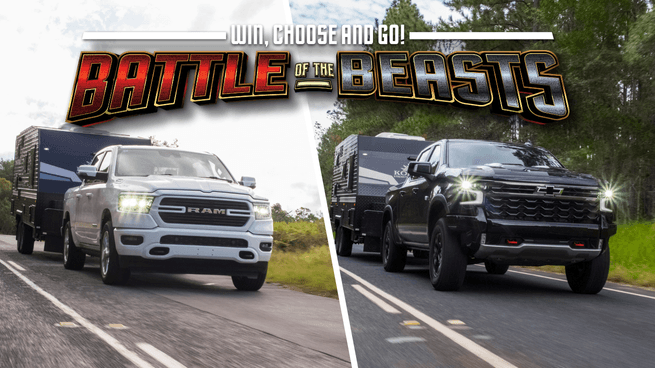Decisions, Decisions: Win a RAM 1500 DT Laramie Sport or Chevrolet Silverado ZR2

Written by Dave Carey
Bigger is always better in the USA, and honestly, Australia shares much the same sentiment. The winning ticket in Mater Cars for Cancer lottery draw 117 gives you an enviable decision to make; take either a RAM 1500 DT Laramie Sport or a Chevrolet Silverado ZR2.

American trucks are gradually filling the void created when the Falcon and Commodore load-luggers departed this mortal coil mid-late last decade. Yes, it was that long ago. Initially it was the Japanese-branded, Thai-built, full-chassis utes that were actively displacing the Aussie utes en masse. Pick-ups like the Toyota Hilux, Nissan Navara and Isuzu D-Max just to name a few, continue to offer efficient diesel drive trains and the dual cab versatility that the modern tradie craves. It’s only the petroleum-sniffing oomph of a ballsy V8 ute that they lack to any degree. Enter the American pick up. But enter the draw first.
From driveways to dustbowls, might is right with SUVs and pickups now comprising 80% of all US-market passenger vehicle sales, up from 50% in 2013. Ford no longer sells a traditional sedan in its home market, despite shifting 63,939 archaic Ford Crown Victorias in 2005 and 46,725 as recently as 2011. They’d be big numbers for Australia, but not so much in the USA, where the sales decrease was both obvious and damning.
Armed with that information, the meteoric rise of SUV and domestic pickup sales in the USA is hardly a surprise, but their relatively recent addition to Australia’s streetscape has been turning a few heads. In truth, the American pick up has been broiling away in the background for decades, with Australian Holden, Ford and Chrysler factories all fielding US-centric contenders over the last 70 years for use in the private, commercial, and emergency services sectors. So, why are they suddenly so popular? Finding out first-hand could be as easy as grabbing a ticket. Still, read on. Sometimes I make sense.

A lack of local load luggers aside, I reckon the American pick-up is seeing a renaissance in Australia because the manufacturers are finally serious about shifting them here. Prior to the 2010s, the American truck was a niche player, and as the Aussie ute has tapped out, the truck has stepped up. Companies like Ateco, the Australian distributors of RAM pick ups and General Motors Special Vehicles, who sell the Chevrolet Silverado, have placed emphasis on re-engineering left-hook, US-market trucks, rather than leaving them as a periphery project.
RAM Trucks Australia parent company American Special Vehicles Pty Ltd, which is owned by Ateco, is the only company worldwide to purchase official, export-spec left-hand-drive RAMs directly from the US factory for remanufacture in Australia. Depending on spec, three to four hundred brand-new, OEM-grade parts are used on the conversion, which requires the entire body be lifted from the chassis.
The RHD-specific dashboard is designed and produced in Australia, as is much of the heating and ventilation systems. If the process sounds expensive, it is, but as discussed ‘might is right’ and sheer numbers make the conversion worthwhile, with more than 18,000 repatriated RAMs calling Australia home since 2013, and the marque now outselling Land Rover. The RAM is selling well, much like tickets to lottery 117, if you get what I mean.

Similar works occur over at General Motors Special Vehicles, who is responsible for Aussifying big Chevrolet trucks like the Silverado. Premoso, part of the Walkinshaw Group, handles the conversion, utilising a brand-new, mirror-image firewall which accepts and therefore retains much of the original Chevy fixtures, albeit on the other side.
Premoso engineers also discovered that the standard, left-hand-drive steering box works perfectly well on the right-hand-drive conversion, once it’s been removed, relocated, and flipped upside down. Like the RAM, the entire body is isolated from the chassis for this work to occur, as is the whole wiring loom. The Silverado also receives a new auto trans selector to suit RHD, and even the door trims get remoulded thanks to the power window switch block requiring relocation from the American driver’s side to the Aussie driver’s side.
The technical wizardry inherent to a modern pickup means the right-hand-drive conversion process is entirely more complicated than it’s been at any other time in history. But if you hold the winning ticket come draw time, you can thank the former Holden Special Vehicles team for their world-class conversions. Experts at every level of vehicle design and construction, their decades spent honing homely Holdens into muscle machines was not wasted when GMH shut their doors, with the former HSV, now Walkinshaw Group handling the conversions on both the RAM 1500 DT Laramie Sport and the Chevrolet Silverado ZR2.
Today, Walkinshaw Group remanufactures more vehicles per year than they ever did under Holden. And they say Australian manufacturing is dead. Nah, it just shifted gears.

Grab a ticket today to support Mater Foundation’s excellent work and put yourself in the draw to make a tough decision; the RAM 1500 DT Laramie Sport and the Chevrolet Silverado ZR2. Either way, it’s been in good hands.


We would love to hear from you
We would love to know what you think about Mater Lotteries!
1800 067 066
All times displayed in your local timezone unless stated otherwise. Mater Foundation Ltd as trustee for Mater Foundation is registered as a charity with the Australian Charities and Not-for-profits Commission. ABN 96723184640. All prices are displayed in AUD.



